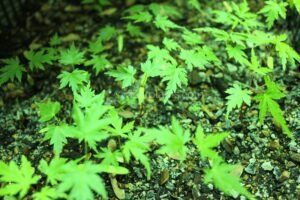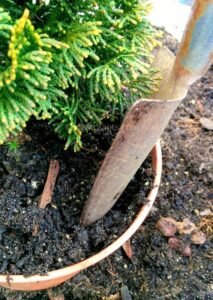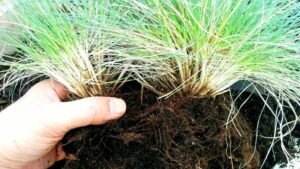Imperata cylindrica ‘Red Baron’ is a grass appreciated for the color of its leaves. In this guide we will learn, step by step, how to divide Japanese blood grass (Imperata cylindrica ‘Red Baron’).
The leaves appear green with a little red at the tip. As the season progresses, the red color spreads through the leaves and by the end of summer, the leaves are all red, with a little green at their base.
This plant is perfect for growing in mixed borders with other grasses or brightly colored flowers. It is also a great choice for growing in pots.
For a more dramatic effect, repeat this plant in groups or create effects like this snake shown in The Garden of Eaden.

Grow Imperata cylindrica ‘Red Baron’ in moist, organically rich soil in full sun as this will produce better colors.
This grass spreads by shooting underground growth. These massifs can be split to form new plants.
In this guide, I will demonstrate how to do multiple divisions and get new plants. I’m going to use plants that are growing in pots.
Although they are two small tufts, it will allow me to make more groups to create a better effect in the garden in the future.

If replanting the divisions directly into the garden, prepare the soil by adding a little slow-release fertilizer, organic matter or decomposed manure.
In this case, I will plant the small divisions in pots to strengthen them before planting them in the final location.
When to divide Imperata cylindrica ‘Red Baron’?
The best time to divide Imperata cylindrica ‘Red Baron’ is early spring. By doing this, the plants will quickly regrow. Alternatively they can be divided in autumn.
Split Imperata cylindrica ‘Red Baron’
First I cut the dead foliage. Spring is coming and this foliage from last year has been left.

You can already see some new growth through the dry foliage.

I remove each plant from the pot carefully turning it upside down.

Then, with my hands and the help of a shovel and scissors, I separate and divide the tufts into several smaller ones.

We can clearly see the natural expansion of this grass through underground shoots.

It’s very easy to separate, the soil is loose and I can see the foliage shoots and their roots well. The more shoots and roots each division has, the better chance of rapidily becoming a vigorous tuft.

However, Imperata cylindrica ‘Red Baron’ can almost be separated into small individual segments as it is a plant that regenerates easily.
In this case it was quite easy to loosen the roots of each division and create each new tuft. This is because the soil was quite loose and easy to handle.
Keep in mind that when dividing large plants to plant in the garden, you must separate them so that each division has several shoots so that it does not lose the effect of the massif.
In this case, I am propagating small plants that will still grow in the nursery until they are big enough to create an impact in the garden.



